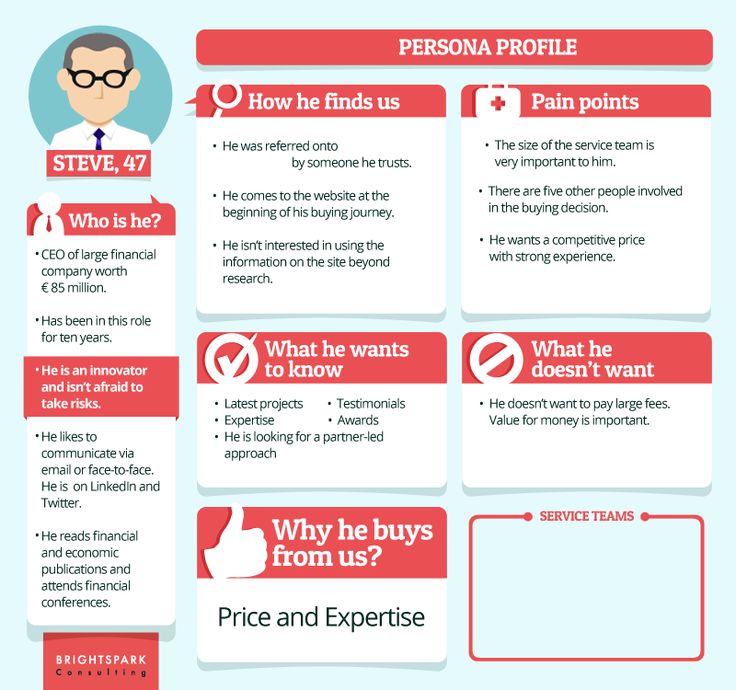*Positioning
Implementing Your Positioning in 9 Steps

Generating more leads and sales? Implementing your positioning according to these 9 steps ensures that it comes across effectively.
Determining a unique and remarkable positioning is often a challenging task, and a team breathes a sigh of relief when it succeeds. But that’s when the real work begins. Implementation is where the success of the positioning stands or falls. This deserves all the attention. That’s why we discuss the 9 steps for implementing your positioning in this article.
Positioning implementation: 9 Steps
 Create a customer profile
Create a customer profile- Map out the customer journey
- Develop a value proposition
- Formulate goals
- Determine KPIs
- Align organizational behavior
- Determine resources and channels
- Track results
- Evaluate and adjust annually
Of course, we would be happy to discuss each step in detail.
1. Creating a customer profile (buyer persona)

Example customer profile (buyer persona) Source
When determining the positioning, we talk about a target audience, a segment in which the majority of our (potential) customers fall. However, this is too general for the implementation of the positioning. Therefore, the first step in implementing the positioning is to create customer profiles.
Creating a customer profile or buyer persona gives a real “face” to your ideal customers. You use all the knowledge you have to describe who this person is and how they think. What occupies her daily life, what attitude does she have towards your product, what criteria does she use to make a decision? The answers to these and many more questions should be reflected in the customer profile you create.
2. Mapping out the customer journey
The next step is to map out the customer journey for each customer profile. The customer journey is the collection of phases a customer goes through in their buying process and interaction with a company. Your research into the customer profile has probably already given you a lot of insight into the contact moments, but it pays off to really think about it and graphically work out the result.
Then, you compare the customer profile(s) with the result and indicate what the most important touchpoints are. These are called ‘Moments of Truth’:
Moment of Truth: The moment when a potential customer comes into contact with a brand, product, or service and forms or changes their opinion about it.
Google distinguishes one more step, the ‘Zero Moment of Truth’. Read all about it here.
Keep in mind that the most important touchpoints often differ per customer profile. It is therefore worthwhile to determine them for each profile.
3. Developing proposition(s)
A proposition is the transactional statement that summarizes why a customer should prefer a specific product or service over all competitors and alternatives. A well-known example is “Melts in your mouth, not in your hand” from M&M’s.
Determine the primary proposition for each customer profile. You can use different structures for this, some examples are:
- We help X with Y so that Z.
- For {customers} who have {problem or question}, there is {product or service} that ensures {result}.
- What, how, why
- {Huge problem}. {Offered solution} that {is different} and {share proof/track record}.
We wrote extensively about the difference between proposition and positioning.
The ultimate goal is to determine the most suitable proposition for each Moment of Truth (important contact moment). This may sound like overkill, but what convinces someone strongly depends on the stage of the sales process they are in. Specific propositions are likely to lead to higher conversion rates. You can also implement this at a later stage and include it as part of the annual evaluation and adjustment process.
4. Formulating objective(s)
What do you want to achieve with your marketing efforts? Probably to attract more customers or leads, but you understand that this objective is too vague. I won’t bore you with the explanation of SMART (Google it yourself) because this should be self-evident.
Another pitfall is not choosing one or a few objectives, but a whole list. So, a higher brand awareness, more leads, greater market share, and better customer retention. Even if your objectives are SMART, having too many objectives makes it harder to make choices.
Noah Kagan, now known for SumoMe but started as employee #30 at Facebook, tells the following about his work at Facebook:
“In every meeting, I had new ideas for Mark (Zuckerberg) to make money. He would look at me and ask, “But how does that get us more users?” If my answer didn’t address that, the action wouldn’t go forward. Mark had only one goal, getting more users. The rest came later. And this is the foundation of Mark and Facebook’s success. When I started SumoMe, I also stuck to a single objective, and it works!”
The best objective(s) are like dominoes, when they fall, the rest follows naturally.
5. Determine KPI’s
There are KPIs, but ideally there should only be one: which variable best embodies the extent to which you meet the goal(s)? Let me give you a concrete example:
During the first few years of Merkelijkheid, within our online-only strategy, we were mainly focused on attracting visitors and expanding our reach. We wrote weekly articles on various topics, some focused on SEO and others on social media. Our goal was to establish and increase brand awareness. Our KPI was the number of unique visitors to our site per month.
After a few years, we had a respectable number of visitors, around 6,000 unique visitors per month at that time. We received occasional calls, but it was not a flood of new customers. During our evaluation, we decided to shift our focus to reaching new potential customers, which meant collecting name, address, and contact information. The overarching KPI was conversion; the percentage of visitors who leave their contact information.
Unfortunately, the goal is not always so straightforward, but I would recommend keeping the number of KPIs as small as possible. It makes evaluation much simpler, and KPIs are important tools for determining both behavior and resources and channels.
6. Aligning organization behavior with positioning
The behavior of your organization should be in line with your positioning:
CoolBlue (service with a smile) has managed to implement its positioning down to the very fibers of the organization. This means that the helpdesk employee looks up your information based on the phone number you call from. They then have a good idea of what your question is about and can take action based on three questions. They are so quick and decisive that it will leave you amazed. And if you hear “Have fun vacuuming!” at the end of your conversation, you can’t help but smile.
Unfortunately, we are much more often confronted with the opposite. A company that does everything to win you over as a customer but then leaves you out in the cold. This is perhaps where the risk of a new positioning strategy failing is greatest; if the organization cannot make the positioning their own.
Describe what behavior fits the customer journey and the key touchpoints with your brand, and give concrete examples. Focus on “do’s” and as few “don’ts” as possible. You want your colleagues to feel confident in how to act, rather than memorizing a list of rules.
7. Determining Resources and Channels
Do we need to create a brochure, and should it be printed or used digitally? Should our brand be found on Instagram or only on LinkedIn? Which trade shows are crucial, or should we better spend that budget elsewhere?
One or more of these questions probably reminds you of difficult internal discussions. These are often hot-button issues for many brands because what worked in the past comes together with the future. The big advantage is that armed with the first six steps, you can now make a clear statement about this.
Customer profile + customer journey = essential channels and resources
You know what your objective is, which customer groups you want to target, and what the most important touchpoints/moments of truth are. At the intersection of these factors, you’ll find the most important resources and channels for your brand. Marketing is often criticized for being mostly guesswork, but by combining these three factors, you use the available resources much more efficiently.
Still having trouble making a decision? Launch a test in which you compare the old resources and channels with the new ones. Make sure you clearly define what the winner determines (what success looks like).
8. Tracking results and continuously improving/tailoring as needed
The measurability of marketing has only increased, reinforced by the customer journey thinking we discussed in step two. The results should naturally be reflected in the KPIs, but you can go a step further.
Think or calculate backwards how the KPI has influenced the results:
For example; five new leads through the website resulted in 2 requests, of which one placed an order. Cost per lead is €100. This means that the order cost you €500. Will you invest more or less time in generating leads through the website?
The above example is, of course, simplistic, but it is very close to reality for many companies. Looking at marketing results in this way often opens the eyes of even the most rigid colleagues.
9. Yearly evaluation and making significant adjustments
Set a hard deadline for the evaluation in which you carefully examine all previous steps.
Questions for (semi)annual evaluation of positioning:
- Do our customer profiles still match, are they really our customers?
- Have any steps in the customer journey been overlooked and what does that mean for our activities?
- Does our proposition convince or would another one work better?
- What has become of our objective?
- Do the KPIs accurately reflect our progress?
- Has the organization embraced the positioning? Why or why not? What can be improved?
- Are we using the right resources and channels?
Positioning is a learning process
Systematically approaching and working with positioning is a learning process. No one has the right answers from the beginning, but with these steps, you will be well-prepared. The last step determines whether you will continue to grow or stand still. If you are in a rapidly changing market, evaluate every six months, but keep in mind that change takes time. Before you see the first results of an online strategy, you can easily be six months down the road, a waste of effort if you stop before then.
If you want to learn more about positioning and how to work on it yourself, read our Positioning page, where you can find in-depth articles and dozens of examples and models for any possible positioning challenge.